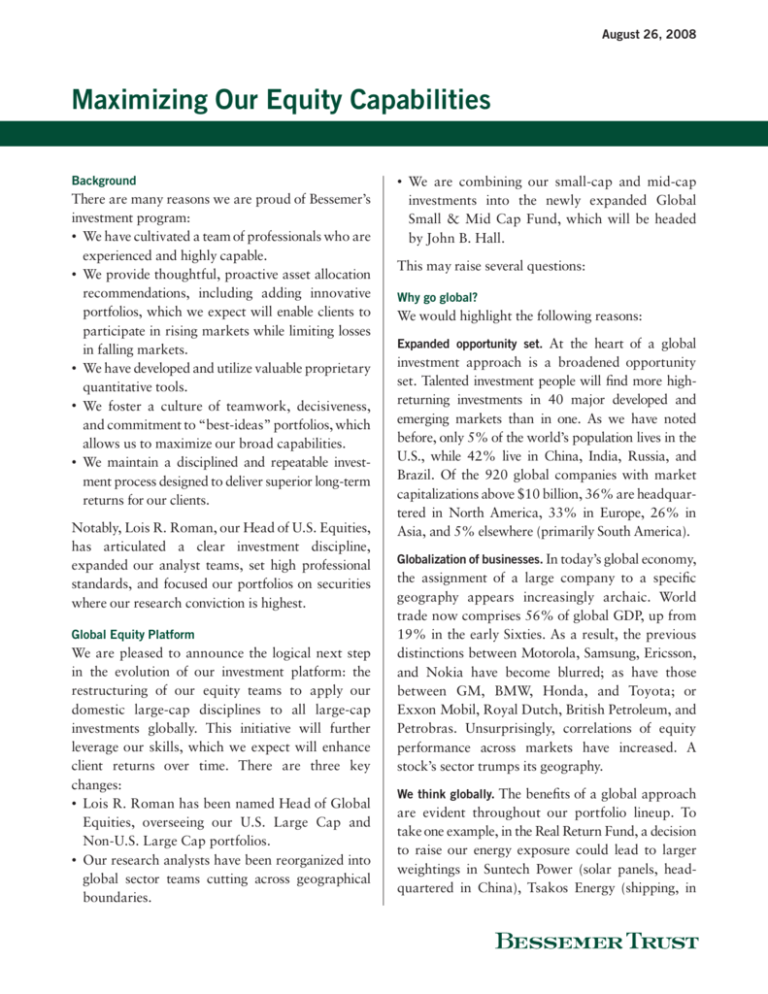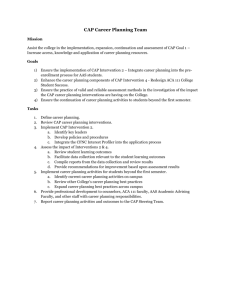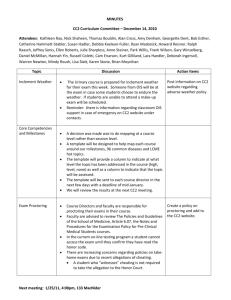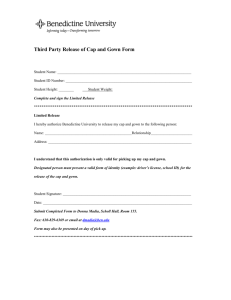
August 26, 2008
Maximizing Our Equity Capabilities
Background
There are many reasons we are proud of Bessemer’s
investment program:
• We have cultivated a team of professionals who are
experienced and highly capable.
• We provide thoughtful, proactive asset allocation
recommendations, including adding innovative
portfolios, which we expect will enable clients to
participate in rising markets while limiting losses
in falling markets.
• We have developed and utilize valuable proprietary
quantitative tools.
• We foster a culture of teamwork, decisiveness,
and commitment to “best-ideas” portfolios, which
allows us to maximize our broad capabilities.
• We maintain a disciplined and repeatable investment process designed to deliver superior long-term
returns for our clients.
Notably, Lois R. Roman, our Head of U.S. Equities,
has articulated a clear investment discipline,
expanded our analyst teams, set high professional
standards, and focused our portfolios on securities
where our research conviction is highest.
Global Equity Platform
We are pleased to announce the logical next step
in the evolution of our investment platform: the
restructuring of our equity teams to apply our
domestic large-cap disciplines to all large-cap
investments globally. This initiative will further
leverage our skills, which we expect will enhance
client returns over time. There are three key
changes:
• Lois R. Roman has been named Head of Global
Equities, overseeing our U.S. Large Cap and
Non-U.S. Large Cap portfolios.
• Our research analysts have been reorganized into
global sector teams cutting across geographical
boundaries.
•
We are combining our small-cap and mid-cap
investments into the newly expanded Global
Small & Mid Cap Fund, which will be headed
by John B. Hall.
This may raise several questions:
Why go global?
We would highlight the following reasons:
Expanded opportunity set. At the heart of a global
investment approach is a broadened opportunity
set. Talented investment people will find more highreturning investments in 40 major developed and
emerging markets than in one. As we have noted
before, only 5% of the world’s population lives in the
U.S., while 42% live in China, India, Russia, and
Brazil. Of the 920 global companies with market
capitalizations above $10 billion, 36% are headquartered in North America, 33% in Europe, 26% in
Asia, and 5% elsewhere (primarily South America).
Globalization of businesses. In today’s global economy,
the assignment of a large company to a specific
geography appears increasingly archaic. World
trade now comprises 56% of global GDP, up from
19% in the early Sixties. As a result, the previous
distinctions between Motorola, Samsung, Ericsson,
and Nokia have become blurred; as have those
between GM, BMW, Honda, and Toyota; or
Exxon Mobil, Royal Dutch, British Petroleum, and
Petrobras. Unsurprisingly, correlations of equity
performance across markets have increased. A
stock’s sector trumps its geography.
We think globally. The benefits of a global approach
are evident throughout our portfolio lineup. To
take one example, in the Real Return Fund, a decision
to raise our energy exposure could lead to larger
weightings in Suntech Power (solar panels, headquartered in China), Tsakos Energy (shipping, in
Maximizing Our Equity Capabilities
Greece), Aker Solutions (energy service, in Norway),
Occidental Petroleum (exploration and production,
in the U.S.), coal in Australia, or electricity in
Germany. Thinking about industries globally forces
an investor to see the broad picture, which can
heighten investment tradeoffs, improve decisionmaking discipline, and enhance return potential.
Why now?
This change builds on our long-standing commitment to thinking globally in asset classes such as
hedge funds and private equity, and it complements
our prior introductions of the Real Return, Global
Small Cap, Global Opportunities, and Global Real
Estate funds.
Following several important developments, we now
have the elements in place to successfully transition
to global investment teams:
Seasoned staff. We have expanded our analyst
ranks, enhancing our ability to assess companies
across geographies. In fact, our experienced analysts
are already examining their industries globally.
They can’t analyze Procter & Gamble’s earnings
prospects without understanding non-U.S. consumer
markets (e.g., China) and non-U.S. competitors
(e.g., Unilever). Shifting to a global equity platform
will formalize an investment approach that is
already in place.
As Head of Global Equities, Lois R. Roman will
continue to rely on a highly capable team that is
focused on uncovering companies that are “underearning” versus their long-term profit potential. She
will draw on her previous experience in managing
portfolios with significant non-U.S. equity exposure,
including 10 years at Scudder and Oppenheimer.
John B. Hall, who will now serve as Portfolio
Manager of the Global Small & Mid Cap Fund, has
a long record as a successful analyst with Bessemer.
More recently, he has served as Research Director
on our Mid Cap portfolio, working closelywith Lois.
2
Disciplined, repeatable process. Now that we are
seeing the fruits of important enhancements we
made to our U.S. equity discipline, including
extensive use of quantitative research, we will
apply this process throughout global markets.
Access to global companies. Large non-U.S. corpo-
rations have significantly increased their overtures
to global investors by visiting major world cities
frequently to meet with investors, hosting regular
conference calls, and providing financial information in accordance with advanced accounting
standards — all of which increase the feasibility
of global analyst teams.
Research partners. In recent years, we have expanded
our collaboration with several global research partners headquartered around the world. We are pleased
with the caliber of information provided by these and
other firms, and we will expand our relationships
with them as we restructure.
Enhanced infrastructure. Our infrastructure is
now better equipped for global investing. Built to
handle the global approaches of Real Return and
Global Opportunities, new processes in our legal,
compliance, trading, and many back-office areas
have paved the way for additional global portfolios.
The timing also appears fortuitous from a tax
perspective: stock prices have declined and capitalgains rates are low. These portfolio transitions will
lead to the realization of capital gains or losses as
positions are sold in our current U.S. Mid Cap and
International portfolios. We are proactively looking
for opportunities to offset gains with losses elsewhere
in our client portfolios in an effort to minimize the
tax costs of these transitions.
How will the U.S. Large Cap, Non-U.S. Large Cap, and
Global Small & Mid Cap portfolios be managed?
All of these portfolios will reflect an integrated
global investment process that includes emphasizing
stocks in which we have high convictions. A
Maximizing Our Equity Capabilities
Exhibit 1: Portfolio Information
U.S. Large Cap
Non-U.S. Large Cap
Global Small & Mid Cap
Market Cap Range
Investment Managers
>$10 billion
Bessemer
>$10 billion
Bessemer
Vehicles
Separately-managed
Common trust fund
Common trust fund
Mutual fund
$250 million-$10 billion
Bessemer
Champlain Investment Partners
Dimensional Fund Advisors
Mutual fund
Mutual fund
S&P 500 Index
MSCI EAFE Index
Benchmark
MSCI World Small Index*
*Under review.
summary of the salient features of these portfolios,
including the investment vehicles available for these
asset classes, appears in Exhibit 1.
We have arranged our New York- and Londonbased research analysts into five teams covering
broad global sectors — financials, industrials/utilities, energy/materials, consumer/healthcare, and
technology/telecom. Our quantitative research
team will continue to play a critical role by screening
huge amounts of global data to prioritize promising
companies for in-depth analyst research.
Did we consider implementing a single Global Large
Cap portfolio?
Yes, but it is not currently feasible because of
restrictions placed on foreign investors by some
overseas markets. A total of 19 countries of interest to us are “beneficial owner markets,” where we
cannot utilize an omnibus investment registration
process that significantly eases the investment
process for separately-managed accounts. These
countries include Brazil, Chile, China, Greece, India,
Malaysia, Russia, South Korea, Taiwan, and Turkey.
While ADRs (non-U.S. securities available on U.S.
stock exchanges) provide a way to purchase some
securities in these countries, the inability to access
all of them precludes this approach now. Over
time, more countries may evolve to permit omnibus
registration, and we will continue to search for other
ways to address this constraint.
Why did we choose to combine small- and mid-cap
investments?
As pleased as we have been with our Mid Cap
and Global Small Cap portfolios — over the past
three years, both portfolios have delivered strong
absolute returns and outperformed their benchmarks — we believe combining these investments
will enhance clients’ long-term return potential
for several reasons.
• Globalizing our mid-cap investments will expand
the opportunity set.
• To manage the enormous universe of 10,115
global small- and mid-cap companies, we will
leverage the collective capabilities of three firms
with distinct competencies: Bessemer, Champlain,
and Dimensional.
• The new structure is designed to enhance our
flexibility. We plan to increase our allocation to
our existing sub-advisers and expand their
mandates, allowing us to benefit from their global
expertise more broadly. The new structure also
permits Bessemer’s mid-cap team to concentrate
on their “top 20” best ideas, which will be selected
to complement the more diversified portfolio
segments of our two sub-advisers. Over time, we
will be able to adjust our market cap exposure
without having to make an overall asset allocation
change and hold appreciated small-cap stocks
whose fundamentals remain attractive but whose
market cap has grown.
3
Ultimately, we believe mid-cap and small-cap stocks
play a similar role in an overall portfolio: to diversify
our core large-cap holdings and provide exposure to
a broader range of investment opportunities.
What are the benefits of investing in a mutual fund
rather than separately-managed accounts?
We see five benefits:
• Because of its inherent complexity, investing
across geographies can be implemented far more
effectively in a commingled fund.
• Daily liquidity is available in a mutual fund.
• Rebalancing between asset classes is faster and
more efficient.
• Management fees and other expenses are fully
tax-deductible at the fund level.
• Tax preparation at year-end is far more straightforward for fund investors, including an easier process
to recapture withholdings of foreign dividends.
What are the fees in the Global Small & Mid Cap Fund
and the Non-U.S. Large Cap Fund?
The Global Small & Mid Cap Fund will retain the
fee structure of the current Global Small Cap Fund.
Expenses on this fund reflect a management fee of
85 basis points plus additional costs of 26 basis
points (1.11% overall expense ratio as of April 30,
2008). These figures include management fees paid
to sub-advisers Champlain and Dimensional. Fees
and expenses incurred within a mutual fund are
normally deductible by the fund against ordinary
income for tax purposes. Depending on the level
and type of income generated by the Fund each
year, the after-tax cost should range from 0.67% to
0.89%, assuming 35% federal and 5% state tax
rates. For a taxpayer subject to AMT, the after-tax
cost should range from 0.74% to 0.89%. In recent
years, the after-tax cost has been closer to the high
end of these ranges because of the preferential tax
rate on qualified dividends.
For the Non-U.S. Large Cap Fund, we anticipate an
overall expense ratio of 1.05%. This figure reflects
our decision to voluntarily waive certain fees.
Previously, our expense ratio in this fund was
1.11% (as of April 30, 2008). As described above,
the after-tax cost will be lower.
Will our asset allocation recommendations change?
At this time, the only change we are making is to
include our newly expanded Global Small & Mid
Cap Fund (Exhibit 2).
Exhibit 2: Balanced Growth Asset Allocation
Fixed Income
22%
U.S. Large Cap
27%
Hedge Funds
12%
Global Opportunities
7%
Real Return
8%
Non-U.S. Large Cap
12%
Global Small & Mid Cap
12%
Reflects anticipated launch of the Global Small & Mid Cap Fund in
October 2008.
Source: Bessemer Trust
Additional information is available from your
Client Account Manager.
This material reflects the views of Bessemer, is for your general information, and is not an invitation to purchase an interest in any fund. It does not take
into account the particular investment objectives, financial situation, or needs of individual clients.
Atlanta • Boston • Cayman Islands • Chicago • Dallas • London
New York • Palm Beach • San Francisco • Washington, D.C.
•
•
Visit us at www.bessemer.com
Copyright © Bessemer Trust Company. All rights reserved.
Los Angeles • Miami • Naples
Wilmington • Woodbridge






